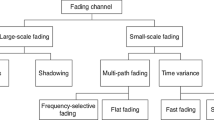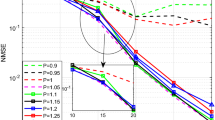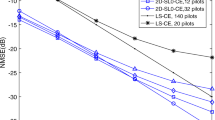Abstract
Massive multiple-input multiple-output (MIMO) employs a large antenna array and is used as a key technology in 5G communication standards. In this work, time-division duplex (TDD) is used for uplink (UL) and downlink (DL) channels as the same bandwidth can be utilized for bidirectional data transfer. This paper proposes a computationally efficient adaptive algorithm based channel estimation model. These models are applicable to multiuser MIMO (MU-MIMO) systems, which are comprised of a large number of channel coefficients. Channel state information (CSI) is acquired from estimated channel coefficients of the UL channel, and CSI of DL is obtained through channel reciprocity. The dynamic characteristics of MIMO channels are generally sparse in nature, and the degree of sparseness varies over time. Convex combination-based modeling with the introduction of l0 norm penalty to Least mean squares (LMS) algorithm develops an efficient and stable sparse channel estimation model, which is the most significant contribution of the paper. The research work presented in the paper has simultaneously focused on channel estimation using the convex combination of momentum-fractional LMS approach and equalization for massive MIMO channels. The simulation result exhibits that the proposed method outperforms the existing conventional compressed sensing (CS) based channel estimation. The UL and DL performance of the system was investigated in terms of bit error rate (BER), mean square error (MSE), and channel capacity calculated from estimated CSI.
























Similar content being viewed by others
References
Larsson, E. G. (2014). Massive MIMO for next generation wireless systems. IEEE Communication Magazine, 52, 186–195.
Lu, L., Li, G. Y., Swindlehurst, A. L., Ashikhmin, A., & Zhang, R. (2014). An overview of massive MIMO: Benefits and challenges. IEEE Journal of Selected Topics in Signal Processing, 8(5), 742–758.
Ngo, Hien Quoc, Larsson, Erik G., & Marzetta, Thomas L. (2013). Energy and spectral efficiency of very large multiuser MIMO systems. IEEE Transactions on Communications, 61, 1436–1449.
Israr, A., Rauf, Z., Muhammad, J., & Khan, F. (2017). Performance analysis of downlink precoding in massive MIMO systems under imperfect CSI. Wireless Personal Communications, 96, 2603–2619.
Riadi, A., Boulouird, M., & Hassani, M. (2020). ZF and MMSE detectors performances of a massive MIMO systems combined with OFDM and M-QAM modulation. Wireless Personal Communications, 116, 3261–3276.
Guerreiro, R., & Dinis, P. (2017). Montezuma, Analytical performance evaluation of pre-coding techniques for nonlinear massive MIMO Systems with channel estimation errors. IEEE Transactions on Communication, 66(4), 1440–1451.
Shin, C., Heath, R. W., & Powers, E. J. (2007). Blind channel estimation for MIMO-OFDM systems. IEEE Transactions Vehicular Technology, 56(2), 670–685.
Noh, S., Zoltowski, M. D., Sung, Y., & Love, D. J. (2014). Pilot beam pattern design for channel estimation in massive MIMO systems. IEEE Journal of Selected Topics Signal Process, 8(5), 787–801.
Nan, Y., Zhang, L., & Sun, X. (2016). An efficient downlink channel estimation approach for TDD massive MIMO systems. In: Proceeding of the IEEE Vehicular Technology, pp. 1–5
Zhu, Fangqi, Na, Wu., & Liang, Qilian. (2017). Channel estimation for massive MIMO with 2-D nested array deployment. Elsevier Physical Communication, 25(2), 432–437.
Nayebi, Elina, & Rao, Bhaskar D. (2018). Semi-blind Channel Estimation for Multiuser Massive MIMO Systems. IEEE Transaction on Signal Processing, 66(2), 540–553.
OrodRaeesi, A., Gokceoglu, Y., Zou, E., & Bjornson, E. (2018). Performance analysis of multi-user massive MIMO downlink under channel non-reciprocity and imperfect CSI. IEEE Transactions on Communications, 66, 2456–2471.
Jeya, R., & Amutha, B. (2019). Optimized semi-blind sparse channel estimation algorithm for MU-MIMO OFDM system. Elsevier Computer Communications, 146, 103–109.
Nan, Y., Zhang, L., & Sun, X. (2015). Efficient downlink channel estimation scheme based on block-structured compressive sensing for TDD massive MU-MIMO systems. IEEE Wireless Communication Letters, 4(4), 345–348.
Uwaechia, A. N., & Mahyuddin, N. M. (2016). A review on sparse channel estimation in OFDM system using compressed sensing. IETE Technical Review, 34(5), 514–531.
Waseem, A., Naveed, A., & Ali, S. (2019). Compressive sensing based channel estimation for massive MIMO communication systems. Hindawi Wireless Communications and Mobile Computing, 8, 1–15.
Nan, Y., Zhang, L., & Sun, X. (2017). Weighted compressive sensing based uplink channel estimation for TDD massive MIMO systems. IET Communications, 11(3), 355–361.
Choi, J., Shim, B., Ding, Y., Rao, B., & Kim, D. (2017). Compressed sensing for wireless communications: Useful tips and tricks. IEEE Communicatons Survey and Tutorial, 19(3), 527–1550.
Khan, I., Singh, M., & Singh, D. (2018). Compressive sensing-based sparsity adaptive channel estimation for 5G massive MIMO systems. Applied Sciences, 8(5), 754–767.
Khan, I., & Singh, D. (2018). Efficient compressive sensing based sparse channel estimation for 5G massive MIMO systems. AEU International Journal of Electronics and Communications, 89, 181–190.
Albataineh, Z., Hayajneh, K., Salameh, H. B., Dang, C., & Dagmseh, A. (2020). Robust massive MIMO channel estimation for 5G networks using compressive sensing technique. AEU International Journal of Electronics and Communications, 120, 1–7.
Singh, V., Srivastava, A., & Jagannatham, A. K. (2020). Superimposed pilots based adaptive time-selective channel estimation in MU-MIMO systems. IEEE National Conference on Communication, 23, 1–6.
Cheng, S., Wei, Y., Chen, Y., Li, Y., & Wang, Y. (2017). An innovative fractional order LMS based on variable initial value and gradient order. Elsevier Signal Processing, 133, 260–269.
Mehmet, Ali Tugay. (1989). YalçinTanik, Properties of the momentum LMS algorithm, Elsevier. Signal Processing, 18(2), 117–127.
Zubair, S., Chaudhary, N. I., Khan, A., & Wang, W. (2018). Momentum fractional LMS for power signal parameter estimation. Elsevier Signal Processing, 142, 441–449.
Gu, Y., Jin, J., & Mei, S. (2009). \(l_0\) Norm constraint LMS algorithm for sparse system identification. IEEE Signal Processing Letter, 16, 774–777.
Das, B. K., & Chakraborty, M. (2014). Sparse adaptive filtering by an adaptive convex combination of the LMS and the ZA-LMS algorithms. IEEE Transactions on Circuits and Systems-I, 61(5), 1499–1507.
Rappaport, T. S. (2002). Wireless communications–Principles and practices (2nd ed., pp. 1–639). Hoboken: Prentice Hall.
Yazdanpanah, H., Diniz, P. S. R., & Lima, M. V. S. (2020). Feature adaptive filtering: Exploiting hidden sparsity. IEEE Transactions on Circuits and Systems-I, 67(7), 2358–2371.
Acknowledgements
Authors acknowledge the support of Institute of Technical Education and Research, Siksha ‘o’ Anusandhan, Jagamara, Bhubaneswar, and Veer Surendra Sai University of Technology, Burla, Sambalpur, India in terms of E-library and Laboratory for successful completion of the research work.
Author information
Authors and Affiliations
Corresponding author
Ethics declarations
Conflict of interest
The authors declare that they have no conflict of interest.
Additional information
Publisher's Note
Springer Nature remains neutral with regard to jurisdictional claims in published maps and institutional affiliations.
Rights and permissions
About this article
Cite this article
Sahoo, M., Sahoo, H.K. Multiuser Massive MIMO Channel Estimation and BER Analysis Using Convex Combination Based Algorithms. Wireless Pers Commun 123, 3025–3049 (2022). https://doi.org/10.1007/s11277-021-09275-5
Accepted:
Published:
Issue Date:
DOI: https://doi.org/10.1007/s11277-021-09275-5




